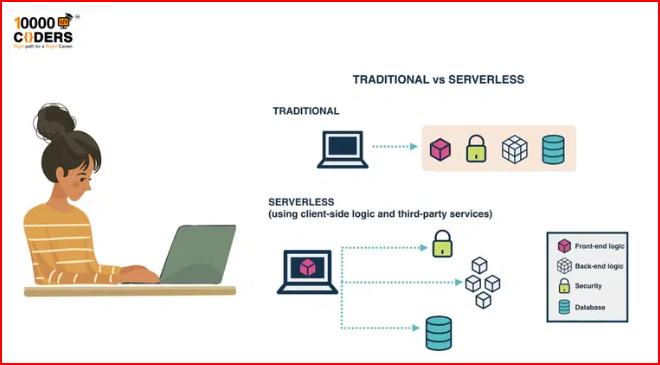Serverless vs Traditional Server Architecture: Which One to Choose?
A detailed comparison of serverless and traditional server architectures to help you make informed decisions for your next project.
Understanding the Basics
Traditional Server Architecture
Traditional Architecture
├── Physical/Virtual Servers
│ ├── Operating System
│ ├── Runtime Environment
│ ├── Application Code
│ └── Dependencies
└── Infrastructure Management
├── Scaling
├── Security
├── Monitoring
└── Maintenance
Key Characteristics
- Full control over infrastructure
- Predictable performance
- Fixed costs
- Manual scaling
- Complete server management
Serverless Architecture
Serverless Architecture
├── Function as a Service (FaaS)
│ ├── Event-driven functions
│ ├── Stateless execution
│ └── Auto-scaling
└── Backend as a Service (BaaS)
├── Managed services
├── API integrations
└── Third-party services
Key Characteristics
- No server management
- Pay-per-use pricing
- Automatic scaling
- Event-driven execution
- Managed infrastructure
Key Differences
1. Cost Structure
Traditional
- Fixed costs regardless of usage
- Hardware and software licenses
- Maintenance and operations
- Staff costs for management
Serverless
- Pay only for actual usage
- No idle resource costs
- Automatic scaling costs
- Managed service fees
2. Scalability
Traditional
Manual Scaling
├── Predict capacity needs
├── Provision resources
├── Configure load balancers
└── Monitor and adjust
Serverless
Auto Scaling
├── Automatic resource allocation
├── Instant scaling
├── No capacity planning
└── Cost optimization
3. Performance
Traditional
- Consistent performance
- Predictable latency
- Warm starts
- Resource optimization
Serverless
- Cold start latency
- Variable performance
- Stateless execution
- Resource constraints
Use Cases
When to Choose Traditional Architecture
- Long-running Processes
- Background jobs
- Batch processing
- Real-time applications
- Predictable Workloads
- Stable traffic patterns
- Consistent resource needs
- Cost optimization
- Specific Requirements
- Custom hardware needs
- Legacy system integration
- Compliance requirements
When to Choose Serverless
- Event-driven Applications
- Webhooks
- IoT data processing
- Scheduled tasks
- Variable Workloads
- Sporadic traffic
- Unpredictable usage
- Cost optimization
- Microservices
- Independent functions
- API endpoints
- Background tasks
Implementation Examples
Traditional Architecture
// Express.js server
const express = require('express');
const app = express();
app.get('/api/users', async (req, res) => {
// Handle request
const users = await db.getUsers();
res.json(users);
});
// Server runs continuously
app.listen(3000, () => {
console.log('Server running on port 3000');
});
Serverless Architecture
// AWS Lambda function
exports.handler = async (event) => {
// Handle request
const users = await db.getUsers();
return {
statusCode: 200,
body: JSON.stringify(users)
};
};
Migration Strategies
From Traditional to Serverless
- Assessment
- Identify suitable components
- Evaluate dependencies
- Calculate costs
- Implementation
- Break down monolith
- Create serverless functions
- Update integrations
- Testing
- Function testing
- Integration testing
- Performance testing
From Serverless to Traditional
- Evaluation
- Cost analysis
- Performance requirements
- Maintenance needs
- Migration
- Consolidate functions
- Set up servers
- Configure infrastructure
- Optimization
- Resource allocation
- Performance tuning
- Cost management
Best Practices
Traditional Architecture
- Resource Management
- Right-size servers
- Load balancing
- Monitoring
- Backup strategies
- Security
- Network security
- Access control
- Regular updates
- Compliance
Serverless Architecture
- Function Design
- Keep functions small
- Optimize cold starts
- Handle errors
- Manage state
- Cost Optimization
- Monitor usage
- Optimize memory
- Cache when possible
- Use appropriate timeouts
Common Challenges
Traditional Architecture
- Scaling Issues
- Over/under provisioning
- Load balancing complexity
- Cost inefficiency
- Maintenance
- Updates and patches
- Security management
- Resource monitoring
Serverless Architecture
- Cold Starts
- Initial latency
- Resource allocation
- Cost implications
- Debugging
- Distributed tracing
- Log management
- Error handling
Future Trends
Traditional Architecture
- Containerization
- Microservices
- Hybrid cloud
- Edge computing
Serverless Architecture
- Multi-cloud
- Edge functions
- Custom runtimes
- State management
Decision Framework
Consider Traditional When
- Predictable workloads
- Long-running processes
- Specific requirements
- Cost optimization
Consider Serverless When
- Variable workloads
- Event-driven needs
- Cost efficiency
- Rapid development
Conclusion
Both architectures have their place in modern application development. The choice depends on:
- Application requirements
- Cost considerations
- Team expertise
- Maintenance capabilities
- Future scalability needs
Next Steps
- Evaluate your requirements
- Calculate costs
- Consider team expertise
- Plan migration if needed
- Monitor and optimize
Resources
Citations
- AWS Serverless Whitepaper
- Microsoft Azure Serverless Architecture
- Google Cloud Serverless
- Serverless Computing: Economic and Architectural Impact
🚀 Ready to kickstart your tech career?





Comments